|
|
|
Sort Order |
|
|
|
Items / Page
|
|
|
|
|
|
|
| Srl | Item |
| 1 |
ID:
100277


|
|
|
|
|
| Publication |
2010.
|
| Summary/Abstract |
This study revisits the debate on trade reform in Latin America, focusing specifically on what combinations of conditions were necessary and sufficient for very rapid trade liberalization. It departs significantly from two types of studies that have been previously used to examine Latin American trade reform: (1) those using large samples and linear statistics to test the mean effects of variables on levels of trade protection and (2) those isolating necessary conditions for rapid reform but using a small number of case studies. Using fuzzy-set qualitative comparative analysis and short case studies, the study considers trade policy in sixty-one administrations. It finds that a key motivating factor for rapid trade opening is potential resistance from protected industry; it further identifies several other important enabling conditions, such as hyperinflation, devaluation, and an unconstrained executive. In combination, these enabling conditions are sufficient to account for a high percentage of rapid reform episodes.
|
|
|
|
|
|
|
|
|
|
|
|
|
|
|
|
| 2 |
ID:
085400
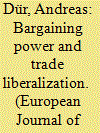

|
|
|
|
|
| Publication |
2008.
|
| Summary/Abstract |
Shortly after the creation of the European Economic Community (EEC, 1958), European countries accepted a far-reaching liberalization of their previously fairly protectionist external trade relations. I provide an explanation of this astonishing development that builds on the argument that the establishment of a customs union increases the bargaining power of its member countries in international trade negotiations. When facing discrimination from a customs union, exporters in excluded countries have an incentive to become politically active and lobby their governments for relief. This increase in exporter lobbying, in turn, weakens the negotiating position of excluded countries in international trade negotiations by making them more eager to achieve a negotiated agreement that lowers the external barriers of the customs union.
|
|
|
|
|
|
|
|
|
|
|
|
|
|
|
|
| 3 |
ID:
082612
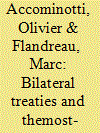

|
|
|
|
|
| Publication |
2008.
|
| Summary/Abstract |
Textbook accounts of the Anglo-French trade agreement of 1860 argue that it heralded the beginning of a liberal trading order. This alleged success holds much interest from a modern policy point of view, for it rested on bilateral negotiations and most-favored-nation clauses. With the help of new data on international trade (the RICardo database), the authors provide empirical evidence and find that the treaty and subsequent network of mfn trade agreements coincided with the end of a period of unilateral liberalization across the world. They also find that it did not contribute to expanding trade at all. This is contrary to a deeply rooted belief among economists, economic historians, and political scientists. The authors draw a number of policy lessons that run counter to the conventional wisdom and raise skepticism toward the ability of bilateralism and mfn arrangements to promote trade liberalization.
|
|
|
|
|
|
|
|
|
|
|
|
|
|
|
|
| 4 |
ID:
131582
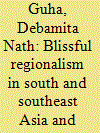

|
|
|
|
|
| Publication |
2014.
|
| Summary/Abstract |
The end of Second World War and the wave of globalization along with the process of trade liberalization have nurtured the emergence of several regional and sub-regional organizations all over the world either in the developed part or in the developing part of the globe. This present paper analyses and contemplates on such type of regional groupings in the South and Southeast Asia which aim at the promotion of peace, stability, security of the hemisphere; greater transaction of trade and finance; and the betterment of overall region and upliftment of the living standards of the people living within the expanse. Here an attempt has been made to diagnose the role of regional and sub-regional organizations in this area namely ASEAN, SAARC and BIMSTEC and also a subsequent study to analyze the patronizing character of India for the furtherance of such groupings.
|
|
|
|
|
|
|
|
|
|
|
|
|
|
|
|
| 5 |
ID:
068923


|
|
|
| 6 |
ID:
115617
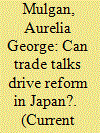

|
|
|
| 7 |
ID:
082246
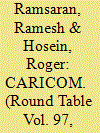

|
|
|
|
|
| Publication |
2008.
|
| Summary/Abstract |
The article examines economic performance in the CARICOM Region against the background of the challenges facing the growth of both regional and international trade. It argues that CARICOM has not only failed to create the expected dynamic in intra-regional trade but has also failed to lay the groundwork for a competitive and efficient manufacturing sector that could exploit foreign market opportunities in an increasingly transparent global economy. A strategy for greater competitiveness needs to embrace a broad range of non-price factors
|
|
|
|
|
|
|
|
|
|
|
|
|
|
|
|
| 8 |
ID:
089321
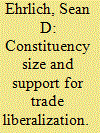

|
|
|
|
|
| Publication |
2009.
|
| Summary/Abstract |
Studies of the political economy of trade frequently rely on the assumption that the larger a policy maker's constituency, the more supportive of free-trade that policy maker will be. Large constituencies are supposed to yield concern for the national interest and provide insulation from particularistic, protectionist interests. This assumption, though, has rarely been directly tested. This article does so by leveraging the variation in district size within the U.S. Congress. This article statistically examines a dataset of roll-call votes on trade legislation from 1994 to 2004 to determine the effect of constituency size and alternative explanations for legislative preferences on foreign economic policy and finds no evidence of the effect of constituency size.
|
|
|
|
|
|
|
|
|
|
|
|
|
|
|
|
| 9 |
ID:
114787
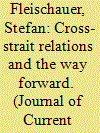

|
|
|
|
|
| Publication |
2012.
|
| Summary/Abstract |
The article focuses on the new policy platform in Taiwan of economic liberalization toward the Chinese mainland. The policy has been the source of both expectation and anxiety. While some observers believe that this will lead to cross-Strait prosperity and peace, others worry about Taiwan's de facto sovereignty and a potentially negative economic impact. In particular, it is claimed that the liberalization process will lead to political integration. The author offers a perspective from the European integration process and argues that integration between China and Taiwan will serve to elevate mutual trust and predictability.
|
|
|
|
|
|
|
|
|
|
|
|
|
|
|
|
| 10 |
ID:
112256
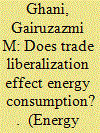

|
|
|
|
|
| Publication |
2012.
|
| Summary/Abstract |
The effect of trade liberalization on the environment can be directly linked to energy consumption, because energy consumption and production are the underlying cause of most pollutants that harm the environment. The descriptive statistics show that average annual growth of energy consumption per capita after trade liberalization varies among countries; hence it is a possibility that the effect of trade liberalization is conditional on factors other than liberalization per se. The regression results show that trade liberalization per se does not affect the growth of energy consumption of the developing countries analyzed, but its interaction with capital per labor reduces the growth of energy consumption as capital per labor increases. However, the effect is only significant after a certain minimum threshold level capital per labor is reached. On the other hand, economic growth increases energy consumption and its effect is not conditioned on trade liberalization. These two different effects mean that, with regards to energy consumption, countries at a higher level of economic development are more likely to reap the benefit of liberalization relative to less developed countries.
|
|
|
|
|
|
|
|
|
|
|
|
|
|
|
|
| 11 |
ID:
157061
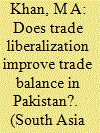

|
|
|
|
|
| Summary/Abstract |
This article examines the impact of trade liberalization, that is, reduction of tariff and non-tariff barriers on trade balance, in Pakistan over the period 1982–2013. The results reveal that reduction of average effective tariff rate improves trade balance in the short run, while lowering of non-tariff barriers deteriorates trade balance in the long run as well as in the short run. The analysis also suggests that depreciation of real effective exchange rate and foreign income causes an improvement in the trade balance, whereas domestic income deteriorates it. The negative association between the reduction in non-tariff barriers and trade balance worsens sustainability of current account of the balance of payments in Pakistan.
|
|
|
|
|
|
|
|
|
|
|
|
|
|
|
|
| 12 |
ID:
155490
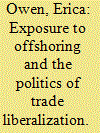

|
|
|
|
|
| Summary/Abstract |
The movement of jobs overseas—known as “offshoring”—is one of the most politically charged aspects of globalization in developed countries. The high salience of offshoring reflects growth in competitive pressures from globalization that directly target individuals’ jobs. I argue that, in a world of fragmented production, how vulnerable one’s occupation is to offshoring helps explain patterns of protectionist sentiment not otherwise accounted for by existing work. I expect that the negative consequences of offshoring for workers will be particularly salient. As a result, vulnerability to offshoring is likely to generate protectionist sentiment toward free trade among constituents. Therefore, legislators whose constituents are vulnerable to offshoring should prove more likely to oppose trade liberalization. I measure vulnerability to offshoring at the district level using data from the US Census. I analyze roll call votes on free trade in the House of Representatives between 2001 and 2006. I find that the larger the share of their constituents who are vulnerable to offshoring, the more likely legislators are to vote against free trade and to discuss the costs of trade for workers in floor debates. My results suggest that the dynamics of offshoring constitute an overlooked dimension to the political economy of trade.
|
|
|
|
|
|
|
|
|
|
|
|
|
|
|
|
| 13 |
ID:
103952


|
|
|
| 14 |
ID:
083490
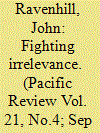

|
|
|
|
|
| Publication |
2008.
|
| Summary/Abstract |
Contrary to expectations at the time, the financial crises of 1997-98 may have strengthened ASEAN. The backlash against a perceived unsympathetic Western response put ASEAN at center stage in new regional cooperative arrangements. Moreover, the rivalry between China and Japan for regional leadership has led them both to seek to negotiate regional partnerships with ASEAN as a whole. ASEAN, however, faces new challenges - particularly from rapid economic growth in China and India, and from the proliferation of preferential trade agreements (PTAs). ASEAN has made only slow progress in economic cooperation, which has fallen further behind schedule. The private sector makes little use of ASEAN's preferential arrangements because they afford little advantage over most-favored-nation tariffs. ASEAN has failed to address 'deeper integration' issues - the removal of 'beyond border' barriers to trade. Some of the bilateral PTAs that ASEAN countries have negotiated with extra-regional partners go further in removing barriers than ASEAN's own arrangements. ASEAN members continue to eschew binding commitments. Liberalization under ASEAN's auspices has not been sufficiently significant to encourage business groups to invest substantial resources in lobbying for deeper integration
|
|
|
|
|
|
|
|
|
|
|
|
|
|
|
|
| 15 |
ID:
092431
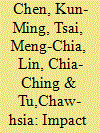

|
|
|
|
|
| Publication |
2009.
|
| Summary/Abstract |
This paper applies a computable general equilibrium model to investigate the potential economic effects of trade liberalization across the Taiwan Strait. Our simulation results reveal that cross-Strait trade liberalization will have significant positive impacts on external trade, domestic investment and real GDP for the economies in this area in general and in Taiwan in particular. Furthermore, the negative impact from the formation of a free trade arrangement between Taiwan and Chinese Mainland on Hong Kong seems to be rather small. These results suggest that cross-Strait trade liberalization is very likely to bring about a win-win situation for the economies in this area.
|
|
|
|
|
|
|
|
|
|
|
|
|
|
|
|
| 16 |
ID:
095930


|
|
|
|
|
| Publication |
2010.
|
| Summary/Abstract |
The central themes to be addressed during the Doha Round of the world trade negotiations are the reduction of the agricultural production and export subsidies and improved market access for agricultural and non-agricultural goods. The G-20 group wields enough power to press negotiations at the Doha Round toward lower agricultural trade barriers and production and export subsidies. The objective of this study is to determine the impacts of the Doha Round on the economies of Brazil, China, and India. The Global Trade Analysis Project's (GTAP) general equilibrium model and database (version 7) are used. The Doha Round scenarios simulated in this paper consider the WTO agricultural production and export subsidy reduction requirement, and the application of the Harbinson approach, and Swiss formula to reduce import tariffs. Brazil and China present the highest GDP growth rate varying from 0.4 % to 1.4%. India shows a negative GDP growth rate in all scenarios, except in that which replicates the Uruguay Round. The welfare gains are positive, but small, for Brazil, China and India. The GDP loss observed in the economies of the EU25 and the US may make it difficult to reach a trade agreement at the Doha Round.
|
|
|
|
|
|
|
|
|
|
|
|
|
|
|
|
| 17 |
ID:
120078


|
|
|
|
|
| Publication |
2012.
|
| Summary/Abstract |
In the backdrop of persistent trade deficit, Bangladesh has been extensively liberalizing its trade regime since 1992 in order to achieve higher export performance and GDP growth. However, despite the liberalization, imports are still growing faster than exports, increasing trade deficit. The article empirically examines the impacts of trade liberalization on export performance in Bangladesh, using the ARDL 'Bounds Test' approach with annual time series data. Empirical results indicate that trade liberalization is having statistically significant but low impact on aggregate export. Neither capital stock as a technology transfers nor liberalization through reduction and withdrawal of export duties shows a significant impact on export performance. Exports are mostly stimulated by GDP growth. The interaction of liberalization with GDP increases exports a little, hence improving the trade balance. However, the liberalization enhances imports compared to exports hence the trade deficit. Therefore, a combined and consistent policy to promote GDP growth, technology transfers and domestic price stability, including education, infrastructures and backward linkage industries is essential in order to achieve higher export performance in Bangladesh.
|
|
|
|
|
|
|
|
|
|
|
|
|
|
|
|
| 18 |
ID:
124302


|
|
|
|
|
| Publication |
2013.
|
| Summary/Abstract |
In large number of circumstances, trade policy modellers turn to partial equilibrium modelling in an imperfect substitutes framework. This article develops a formal representation of this imperfect substitutes model and applies it to trade liberalization within the negative list between Pakistan and India following Pakistan's decision to grant most favoured nation (MFN) status to India. It provides estimates for ranges of output and welfare effects for a number of sectors of interest. It sets these results within the history of Pakistan - India trade and the political economy of the negative list.
|
|
|
|
|
|
|
|
|
|
|
|
|
|
|
|
| 19 |
ID:
116147
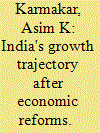

|
|
|
| 20 |
ID:
169155
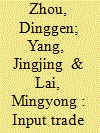

|
|
|
|
|
| Summary/Abstract |
This paper introduces a quasi‐natural experimental framework into trade policy evaluation and reassesses China's trade liberalization through the survival of export products. We use propensity score matching and China's dual trade system to design a quasi‐natural experiment based on Chinese industrial enterprises, customs import and export, and tariff data over the period of 2000–2006; we then use survival analysis to study the impacts of China's trade liberalization on the export duration of manufacturing firms’ products. We find that the substantial reduction in import tariffs after China's accession to the World Trade Organization enhances the export duration of firm products, indicating that trade liberalization ameliorates the survival of export products. The promotion effects of tariff reduction on export duration are obviously stronger for core products than for noncore products.
|
|
|
|
|
|
|
|
|
|
|
|
|
|
|
|
|
|
|
|
|